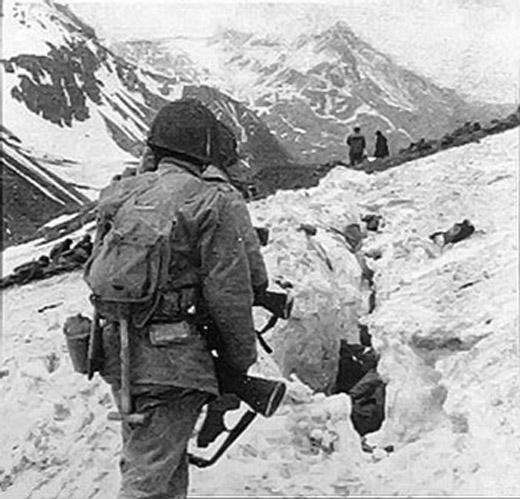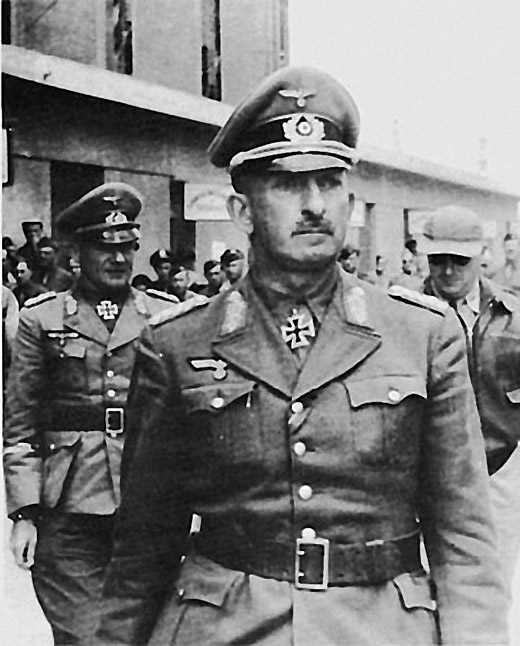Air Operations, Aleutians
- Despite bad weather, a small number of 11 Air Force aircraft are able to support US 7th Infantry Division troops battling Japanese Army defenders on Attu Island. 1 28th Composite Bomb Group B-24 drops supplies to ground forces, and 6 B-24s and 6 343rd Fighter Group P-38s attack ground targets. Several aircraft, however, mistakenly attack US troops, thus allowing retreating Japanese Army troops to escape.
- 1 USS Nassau-based VMO-155 F4F photographic-reconnaissance F4F and its pilot are lost in an operational accident.
Air Operations, Bismarcks
- 43rd Heavy Bomb Group B-24s attack airfields in the Rabaul area.
- V Bomber Command B-25s attack the Gasmata airfield on New Britain.
- B-24s and 43rd Heavy Bomb Group B-17s mount individual attacks against Cape Gloucester and Gasmata, and barges near Ubili.
Air Operations, CBI
CHINA- In their strongest attack against a USAAF target in the theater to date, 27 Ki-21 'Nate' fighters, escorted by 40 other fighters, attack the airfield at Kunming. Although only 4 23rd Fighter Group P-40s are in position to deter the attack, most of the Japanese bombs fall short. 1 B-24 and 1 B-25, however, are destroyed. As the Japanese withdraw, they are intercepted by nearly 30 23rd Fighter Group P-40s from nearby bases, with the result that 2 Ki-21 'Nates' and 14 Ki-43 'Oscar' fighters are shot down.
Air Operations, Central Pacific
11 307th Heavy Bomb Group B-24s under VII Bomber Command control are dispatched from Midway to attack Wake, but only 7 B-24s are able to locate the target and deliver an attack. 22 Japanese Navy fighters attack the bombers, and 1 B-24 is forced to ditch at sea. 1 crewman is lost in the crash, but all the others are rescued by a US Naby ship. This is the first VII Bomber Command loss to enemy action.
[Air Operations, Europe
There is a night raid on Sunderland.
BOMBER COMMANDDaylight Ops:
- 24 Bostons and 12 Mitchells are sent to bomb various targets but half of each plane type is recalled. 12 Bostons bomb the Poix airfield and 6 Mitchells attack an industrial target at Caen.
- There are no losses.
- 3 Mosquitos are sent to Berlin and there are 16 OTU sorties.
- There are no losses.
GERMANY:
- Of 80 1st and 4th Heavy Bomb Wind B-17s sent to Emden, 59 drop 139 tons of bombs on the target.
- 1 B-17 is missing, 9 damaged; 10 crewmen missing
NETHERLANDS:
- Although briefed to bomb Wilhelmshaven, 76 of 113 1st Heavy Bomb Wing B-17s attack targets of opportunity along the Dutch coast with 186 tons of bombs.
- 5 B-17s are lost, 28 damaged; 1 crewman killed, 7 wounded, 51 missing
- 116 VIII Fighter Comman sorties are mounted over the Continent or the English Channel, and several Luftwaffe fighters are engaged by the 56th Fighter Group planes over Rotterdam, but only 2 Luftwaffe fighters are damaged.
Air Operations, New Guinea
- 90th Heavy Bomb Group B-24s attack Nabire.
- V Bomber Command B-25s and A-20s attack the airfield at Lae.
- The crew of a 6th Night Fighter Squadron P-70 on loan to the 5 Air Force bring down a Japanese twin-engine bomber over Port Moresby at 2005 hours.
Aleutians
The 3rd Battalion, 17th Infantry, is withdrawn from the Massacre Bay line on Attu, leaving the 2nd Battalion, 32nd Infantry, to continue the attack. No progress is made, despite close artillery support before and after the jump-off. Dense fog postpones the attack of the Holtz Bay force until 1100. As the fog is lifting it is discovered that the enemy has withdrawn to a ridge in the center of the valley, abandoning prepared positions and quantities of food and ammunition. Pursuit of the enemy across an open valley is slowed by enemy fire from the commanding heights and is further handicapped by an Allied air strike that hits the 7th Division force by mistake. The provisional battalion that landed on Beach Scarlet on D-Day joins the main northern force.
American Troops on Attu |
 |
Battle of the Atlantic
- The Cuban sub-chaser CS-13 and a US naval land-based aircraft (VS-62) sink U-176 off Havana.
- U-266 is spotted by Halifax 'M' of No 58 Squadron which maneuvers in order to attack from out of the sun. Depth charges are dropped from the port quarter and seem to explode right underneath the submarine.
- U-463 is spotted on the surface by Halifax 'R' of No 58 Squadron. The submarine dives on seeing the aircraft, but the attack is carried out with depth charges falling all around the swirl made by the U-boat. Wreckage and oil soon appeared on the surface.
|
|
| Class | Type XIV |
| CO | Korvettenkapitän Leo Wolfbauer |
| Location | Western Approaches, SW of Isles of Scilly |
| Cause | Air attack |
| Casualties | 46 |
| Survivors | None |
CBI
CHINA- In order to repulse the 'rice offensive' launched by the Japanese in the center of the country, Chiang Kai-shek orders Gen Chen Cheng to come back with his army and defend Yichang, on the Yangtze.
- The Combined Chiefs of Staff decide to give absoulute priority to the construction of the airfield in Assam, India. The quantity of war materials to be supplied to China will be increased to 7,000 tons a month by June 1.
Eastern Front
The Germans attempt a small attack in the Leningrad sector but fail to make any progress.
[North Africa
TUNISIAThe pro-Axis Bey of Tunis is deposed.
Gen Hans-Jürgen von Arnim |
 |
Occupied Yugoslavia
The fifth Axis offensive (Operation 'Black') against Tito's Partisans begins. It will last about a month. 120,000 Germans, Italians, Bulgarians and Croats will participate supported by the Luftwaffe.
[<
Pacific
The US submarine Gar (SS-206) attacks a Japanese convoy at the eastern entrance of the Verde Island passage and sinks the army cargo ships Meikai Maru (3197t) and Indus Maru (4361t) between Dumali Point, Mindoro and Marinduque Island.
[a id="43051507">
Soviet Union, Politics
The Soviet authorities decide to dissolve the Comintern to 'prove' to the West that Russia no longer has any expansionist aims. The dissolution is announced on May 22.
In a gesture designed to reassure his Western Allies that the USSR is no longer trying to foment world revolution, Stalin dissolved the Comintern. The latter, founded in 1919 by Lenin and the Bolsheviks, is dedicated 'by all available means, including armed force, for the overthrow of the international bourgeoisie and for the creation of an international Soviet republic as a transition stage to the complete abolition of the State'. The Americans in particular were keen for this organization to be disbanded.
[